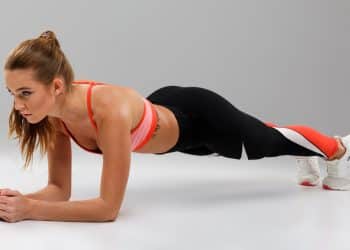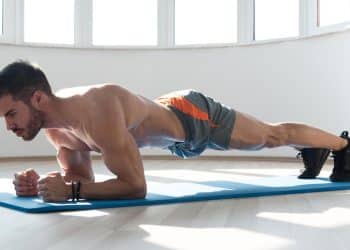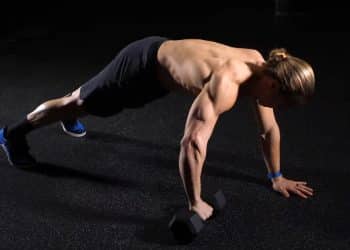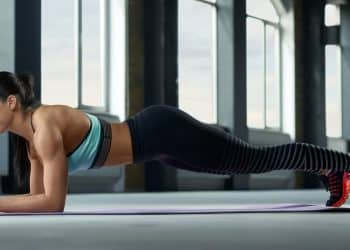Planks are one of the most popular exercises around. With roots in yoga and Pilates, the plank has been a core training staple for longer than I can remember, which is a long time, given I’ve been a personal trainer for more than 30 years!
However, despite their popularity, planks have a downside; they’re often too easy for anyone other than beginners. If you can plank for more than a couple of minutes, they probably aren’t challenging enough to deliver many benefits.
The good news is that there are several ways to make planks more challenging. For example, you can do weighted planks, rocking planks, and suspension trainer planks. Copenhagen planks are another plank variation that will elevate your core workouts. This demanding exercise not only targets your abs but your inner thighs, too.
These muscles often work together to stabilize your hips and pelvis, which means the Copenhagen plank is a very functional exercise. In fact, this move comes from professional soccer and was originally devised as a prehab exercise for FC Copenhagen (1).
In this article, I reveal how and why to do the Copenhagen plank and share three of my favorite variations.
Copenhagen Plank: Correct Form
Make Copenhagen planks as effective as possible by following these step-by-step instructions!
Level Up Your Fitness: Join our 💪 strong community in Fitness Volt Newsletter. Get daily inspiration, expert-backed workouts, nutrition tips, the latest in strength sports, and the support you need to reach your goals. Subscribe for free!
- Lie on your side with your elbow directly below your shoulder. Your hips should be stacked and square. Brace your core.
- Place your uppermost leg on a bench and rest your other leg on the floor beneath it.
- Press your upper foot down into the bench and lift your hips up so your body is straight.
- Raise your lowermost leg off the floor and extend your arm up toward the ceiling.
- Keep your body straight and hold this position for the prescribed time, e.g., 30-45 seconds.
- Lower your hips to the floor, roll over, switch sides, and repeat.
Muscles Worked
Copenhagen planks involve body parts, both big and small. However, the main muscles developed by this exercise are:
- Rectus abdominis
- Obliques
- Transverse abdominis
- Erector spinae
- Quadratus lumborum
- Adductor longus, brevis, and magnus
- Iliopsoas
- Deltoids
Pro-Trainer Tips
Get more from Copenhagen plank with these tried-and-tested pro-trainer tips.
- Place a folded exercise mat or cushion under your elbow for comfort.
- Home exercisers can use a chair instead of a bench for this exercise.
- Lift your hips higher to increase core and adductor engagement.
- Extend and lock your knees to stabilize your lower body.
- Squeeze your feet inward to enhance your balance.
- Train your weak side first and then match your performance on your strong side to eliminate any left-to-right strength imbalances.
Copenhagen Plank Mistakes to Avoid
Make Copenhagen plankas safe and effective as possible by avoiding these common mistakes.
- Do not hold your breath, as doing so can lead to dizziness and high blood pressure. Instead, try doing this exercise for a set number of breaths, e.g., 10, which encourages deep, even breathing.
- Start with short holds and increase duration gradually. This exercise is known for causing deep post-workout muscle soreness, especially in the adductors/inner thighs.
- Do not twist your hips or shoulders. Perform this exercise in front of a mirror to monitor your posture and ensure your body is perfectly straight.
Copenhagen Plank Benefits
Not sure if the Copenhagen plank deserves a place in your workouts? Consider these benefits and then decide.
Time-Efficiency
Copenhagen planks work lots of muscles simultaneously. This is a much more time-efficient way to work out than training each muscle separately in isolation. In simple terms, Copenhagen planks work your core and legs together, shaving valuable minutes off your workouts.
Accessibility
All you need to do Copenhagen planks is an exercise bench. No bench? No problem, as you can also use a chair.
In addition, there are floor and suspension trainer variations of the Copenhagen plank, which are detailed toward the end of this article. You can also modify it to make it easier. Consequently, this is an accessible exercise that’s suitable for all fitness levels.
Injury Prevention
Before making it into mainstream fitness, the Copenhagen plank was a prehab exercise for professional soccer players. It targets the core and muscles of the inner thigh, which stabilize the hips and pelvis.
Studies suggest that Copenhagen planks are an effective way to prevent groin strains and sports hernias. As such, they’re a good option for athletes from all sports (1).
Functional Strength
Muscles rarely work in isolation. Instead, most human movements involve multiple muscles contracting in a coordinated way. Copenhagen planks target your diagonally opposite core and leg muscles, which is how they work during most unliteral or single-legged activities, e.g., walking and running. Consequently, Copenhagen planks are a very functional exercise.
Level Up Your Fitness: Join our 💪 strong community in Fitness Volt Newsletter. Get daily inspiration, expert-backed workouts, nutrition tips, the latest in strength sports, and the support you need to reach your goals. Subscribe for free!
Variety and Challenge
Conventional planks are an effective and popular core exercise. However, doing the same exercise over and over can become boring, and your workout may lose some of its effectiveness. Copenhagen planks are a great way to progress your core training, adding variety and increasing exercise intensity at the same time.
Copenhagen Plank Programming
How often and how long should you do Copenhagen planks? I suggest doing them 2-3 times per week on non-consecutive days, e.g., Monday and Thursday, or Monday, Wednesday, and Friday.
In terms of duration, hold the Copenhagen plank for as long as it takes to feel the target muscles working hard. This could be anywhere from 20 to 60 seconds, depending on your current fitness. Gradually increase the duration, e.g., by five seconds a week, to maintain your progress.
Regarding sets, 2-3 should be sufficient for most people. If you feel that you need to do more, I suspect you are either stopping your sets too soon or resting too long.
Related: Planking It! Five-Minute Plank Workout for Shredded Abs
Copenhagen Plank Variations
I’m a massive fan of Copenhagen planks. Still, I also acknowledge that exercise variety can help make your workouts even more enjoyable and effective. With that in mind, here are three additional variations of the Copenhagen plank to try.
1. Copenhagen Floor Plank
Not having a bench may seem like a barrier to doing Copenhagen planks, but it doesn’t have to be, as you perform this variation on the floor. The angle of your body makes this exercise a little easier than the original, but that’s a small price to pay for such convenience. Do this exercise anywhere and anytime that you want to work your core and adductors.
2. Short Lever Copenhagen Plank
Make no mistake about it, conventional Copenhagen planks are a challenging exercise. That’s especially true for beginners, heavy exercisers, and those returning from injury. Bending your legs shortens the levers to take stress off your muscles and joints. Master this exercise before moving on to the full Copenhagen plank.
3. Suspension Trainer Copenhagen Plank
Doing Copenhagen planks with one foot in a suspension trainer will challenge your core and thighs in multiple planes of motion. You’ll need to dig deep to stop your body from swinging or rotating, making this a very challenging and functional exercise. Use a TRX or any other brand of suspension trainer.
Closing Thoughts
I have nothing against conventional planks. However, I believe anyone who can do more than a couple of minutes needs to move on to a more demanding exercise. After all, the only way to change your body is to challenge it and not do more of an exercise you already find easy.
For this reason, I’m not a fan of things like 30-day plank challenges, where you work up to holding a plank for ten minutes or more. For most people, workouts like that are a waste of valuable time.
So, instead of chasing longer planks, I recommend looking for ways to make them harder. Examples include the RKC plank, weighted planks, hollow body planks, and feet-elevated planks.
And now you can add another progression to your core exercise arsenal – Copenhagen planks.
Copenhagen planks are more challenging than the conventional variation, so you don’t need to do them for as long. They also work the often-neglected adductors or inner thighs, making them a great way to build functional fitness and strength.
Finally, remember that Copenhagen planks come from the demanding world of professional soccer. So, if they’re good enough for those guys, they’ll probably make an excellent addition to your core workouts, too.
References:
- Alsirhani AA, Muaidi QI, Nuhmani S, Thorborg K, Husain MA, Al Attar WSA. The effectiveness of the Copenhagen adduction exercise on improving eccentric hip adduction strength among soccer players with groin injury: a randomized controlled trial. Phys Sportsmed. 2024 Mar 1:1-10. doi: 10.1080/00913847.2024.2321958. Epub ahead of print. PMID: 38376593.
Interested in measuring your progress? Check out our strength standards for Hip Adduction.











